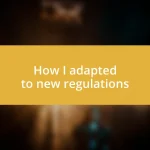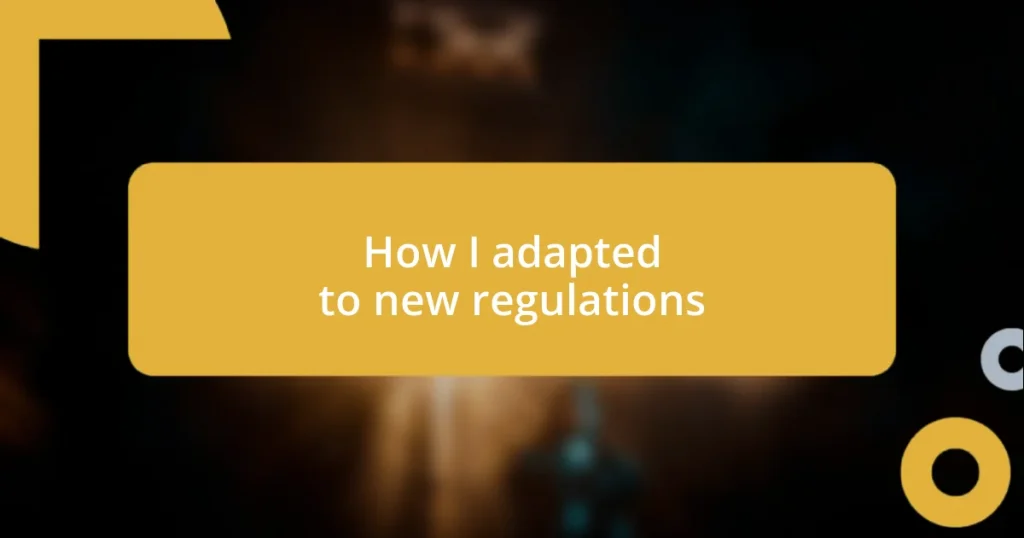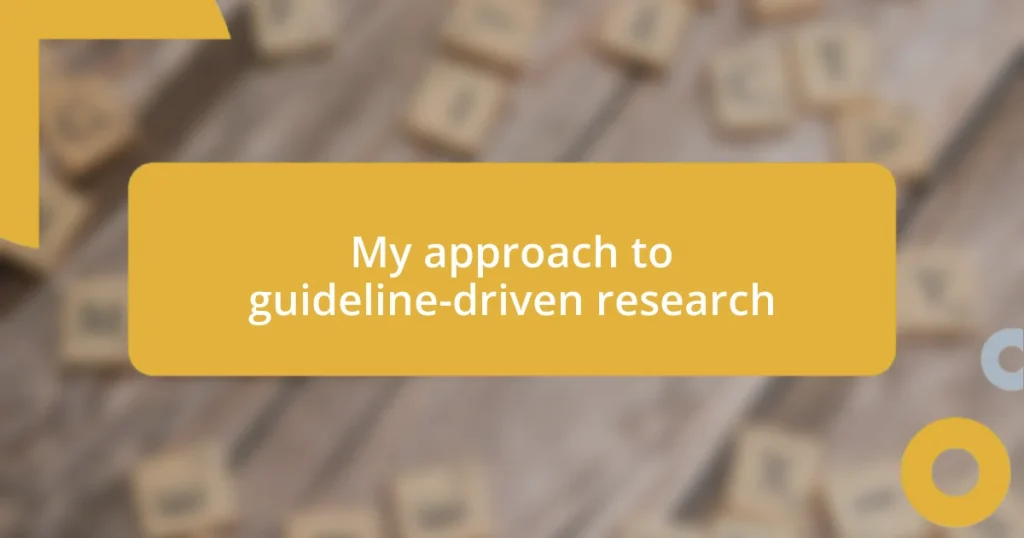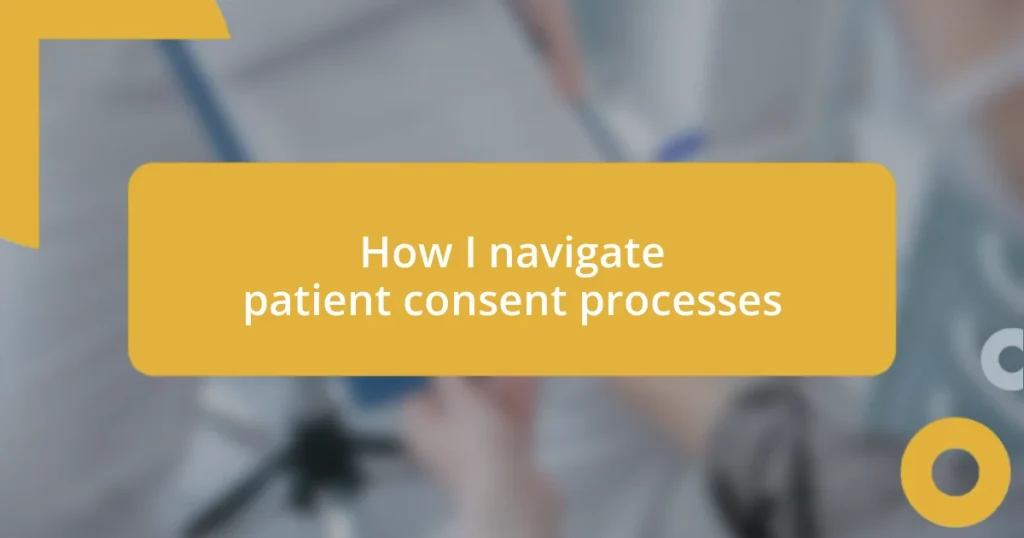Key takeaways:
- Breaking down complex regulations into manageable parts and collaborating with peers fosters understanding and innovation in compliance efforts.
- Implementing training sessions and encouraging open feedback promote team engagement, adaptability, and a culture of continuous improvement.
- Documenting lessons learned enhances organizational learning, ensuring future teams benefit from past experiences and fostering a culture of transparency.
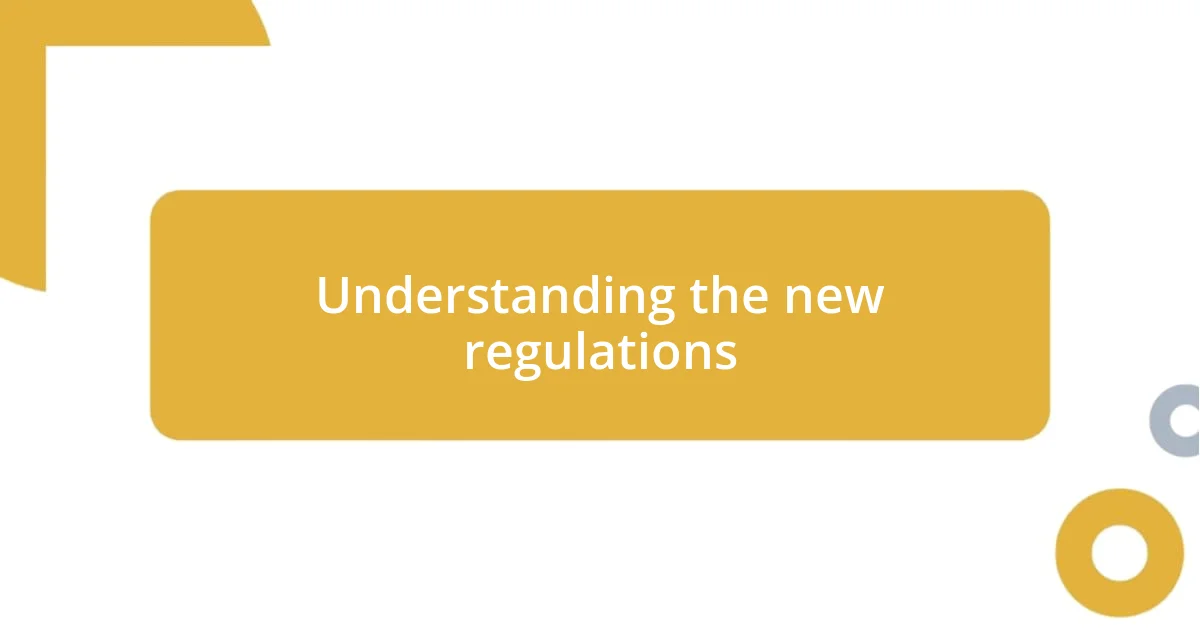
Understanding the new regulations
Understanding new regulations can sometimes feel overwhelming. I remember when I first heard about the changes; it was like trying to decipher a foreign language. The complexity of legal jargon made me question whether I’d ever fully grasp the implications. How often do we find ourselves stumped by terms that seem to complicate rather than clarify?
As I delved deeper, I realized that breaking these regulations into manageable parts was essential. Each rule often tied back to a fundamental goal, like protecting consumer rights or enhancing safety standards. When I approached it from that perspective, the information started to fit together like a puzzle rather than a tangled web. Is there a better way to engage with something than to see how it fits into the bigger picture?
I also found it incredibly helpful to discuss these regulations with peers. Sharing interpretations and insights created an environment where questions flourished. One enlightening conversation revealed how slight nuances in wording changed the approach to compliance, making me appreciate the importance of collaboration. Have you ever noticed how a fresh perspective can suddenly illuminate something you’ve been struggling to understand?
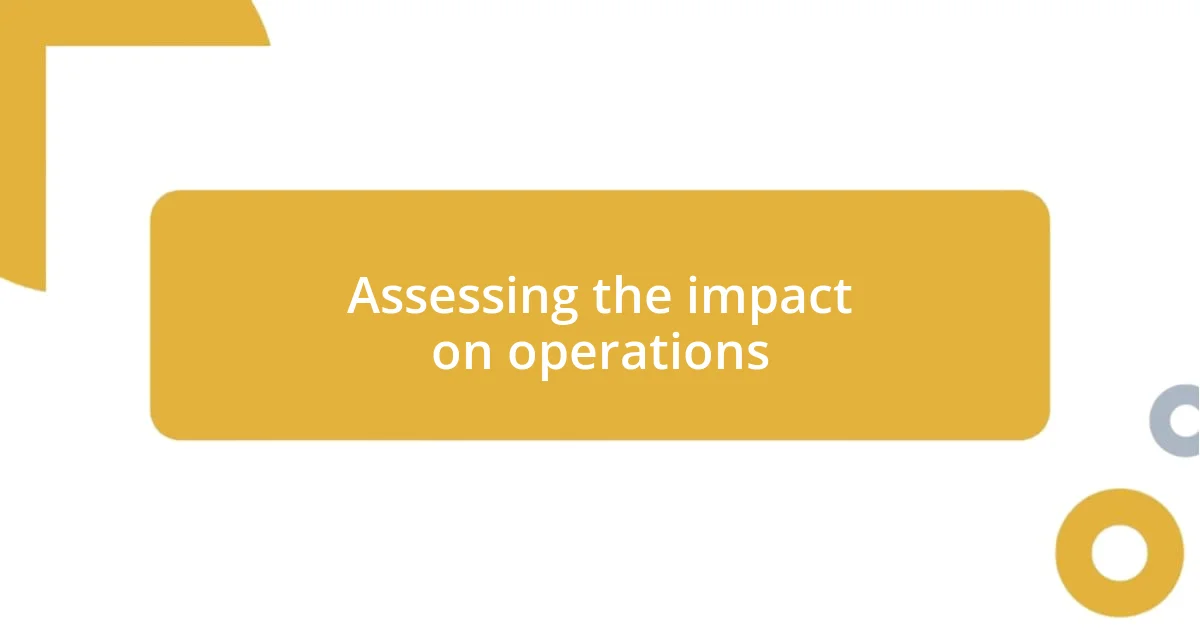
Assessing the impact on operations
Assessing the impact on operations required a detailed look at how the new regulations altered our daily processes. I vividly recall a meeting where we mapped out our workflows. As we laid everything out on paper, it became clear that certain tasks would need restructuring to align with compliance requirements. It felt daunting initially, but I realized that this was an opportunity for improvement—a chance to streamline processes and reduce inefficiencies.
As we dove deeper into the impact assessment, I noticed that some departments faced more significant changes than others. For instance, the compliance team had to expand their reporting activities, which meant implementing new software and training. I remember my colleague’s worry about the transition. Yet, by collaborating closely and embracing the change, we found innovative solutions that not only met the regulations but also boosted our overall productivity. How often do we underestimate the adaptability of our teams when faced with new challenges?
Moreover, the ongoing assessments revealed unintended benefits. For example, a new auditing process improved our quality control, leading to better product outcomes. It was rewarding to witness our collective efforts transform what initially felt overwhelming into a platform for growth. Have you ever experienced a situation where what seemed like a hurdle turned into an advantage?
| Aspect | Previous Operations | Post-Regulations Operations |
|---|---|---|
| Workflow Structure | Linear process | Restructured with compliance checkpoints |
| Departmental Changes | Stable roles | Expanded responsibilities for compliance team |
| Quality Control | Basic review | Enhanced auditing processes |
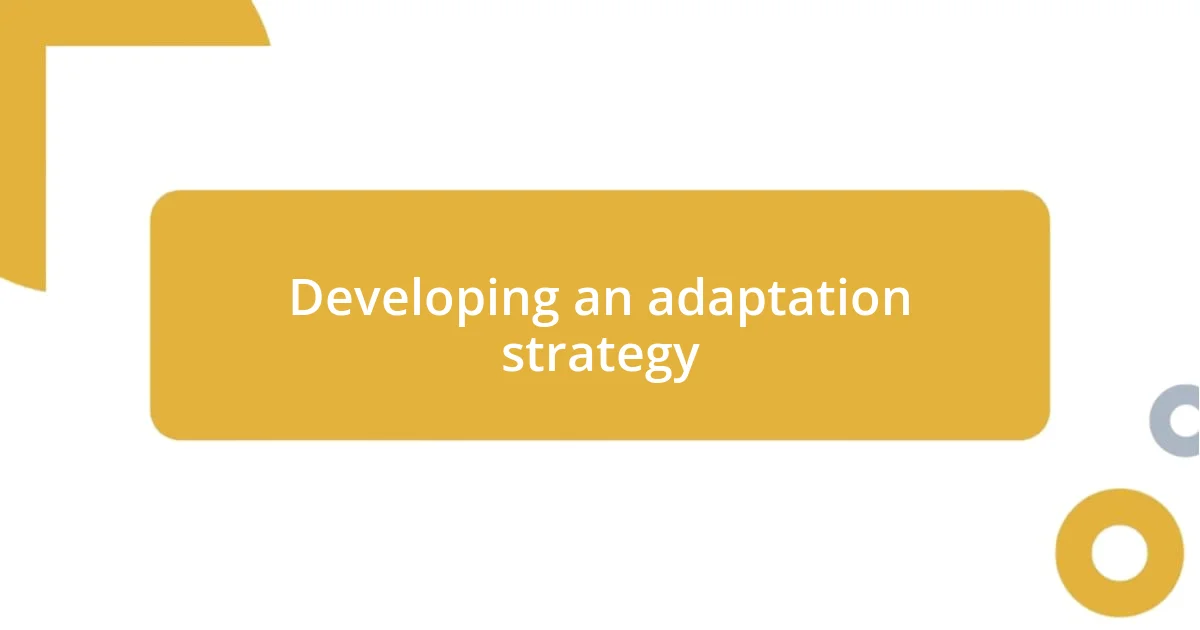
Developing an adaptation strategy
Developing an adaptation strategy is crucial for navigating new regulations effectively. I remember sitting down with my team, brainstorming ideas while sipping coffee. It was during this casual yet productive session that we realized we needed a structured plan. We agreed that understanding the regulations was just the starting point—it was equally important to articulate clear objectives for how we would adapt our operations. It’s interesting how a simple discussion can lay the groundwork for a robust strategy, don’t you think?
To craft this strategy, I gathered insights from various departments, ensuring inclusivity in the approach. This collaboration helped us identify key focus areas and tailor our responses. Here are some elements that shaped our adaptation strategy:
- Identify Key Objectives: What specific outcomes do we want to achieve?
- Engage Stakeholders: Involve everyone from management to frontline staff to gather diverse perspectives.
- Prioritize Training: Ensure all employees understand the new regulations and their implications through workshops.
- Set Milestones: Establish timelines for compliance checkpoints to monitor our progress.
- Evaluate and Revise: Regularly assess the strategy’s effectiveness and be ready to make necessary adjustments.
Each step in our planning felt like assembling a toolkit designed to not just comply but thrive under the new regulations. It was empowering, a chance for us to redefine our operational strengths while embracing change.
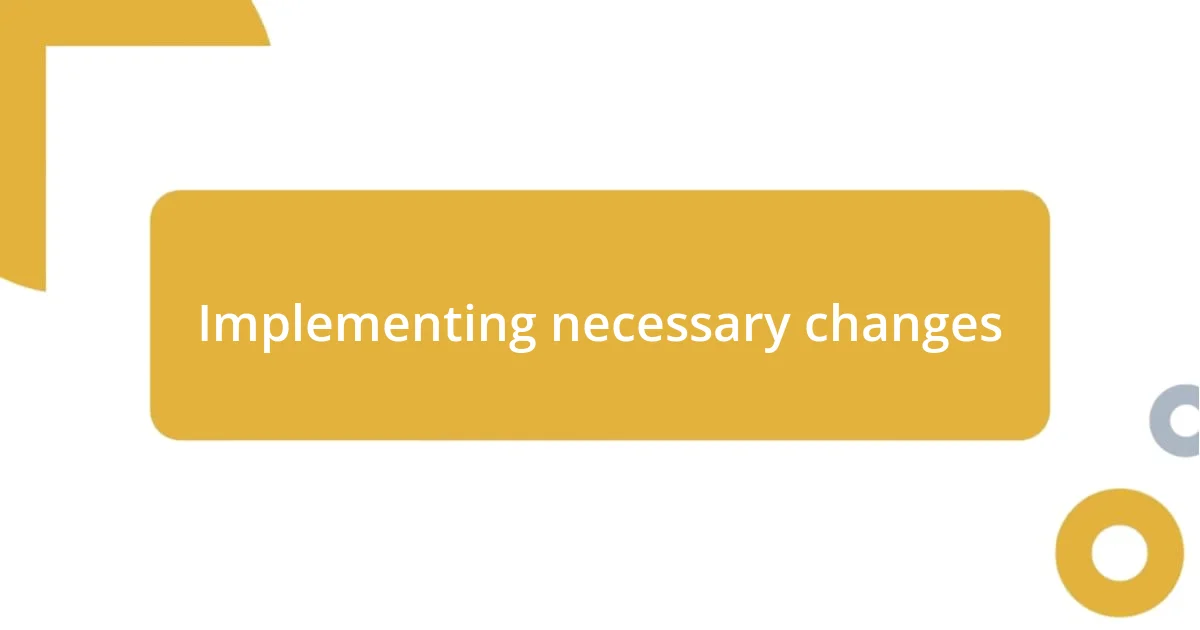
Implementing necessary changes
Implementing the necessary changes to comply with new regulations required a hands-on approach. I remember the first time we decided to hold training sessions for our team. It felt like we were diving into uncharted waters, but sharing knowledge not only equipped everyone with the tools they needed, but it also fostered a sense of camaraderie that brought us closer together. Have you ever noticed how collaboration can transform uncertainty into teamwork?
The adjustments weren’t just procedural; they changed the very fabric of our workplace culture. For instance, I initiated weekly check-ins to gauge how my colleagues were feeling about the ongoing changes. These sessions became a safe space for expressing concerns and sharing triumphs, creating a powerful feedback loop. I found that acknowledging their emotions helped ease the transition, making the shift feel less like a burden and more like a collective journey toward improvement.
As we implemented these necessary changes, I learned the value of staying adaptable. One day, while reviewing our progress, we stumbled upon a few surprising insights—some changes actually enhanced cross-departmental collaborations. Initially, I feared disruptions, yet I realized these adjustments had broken down silos we didn’t even know existed. Isn’t it fascinating how embracing change often reveals new opportunities?
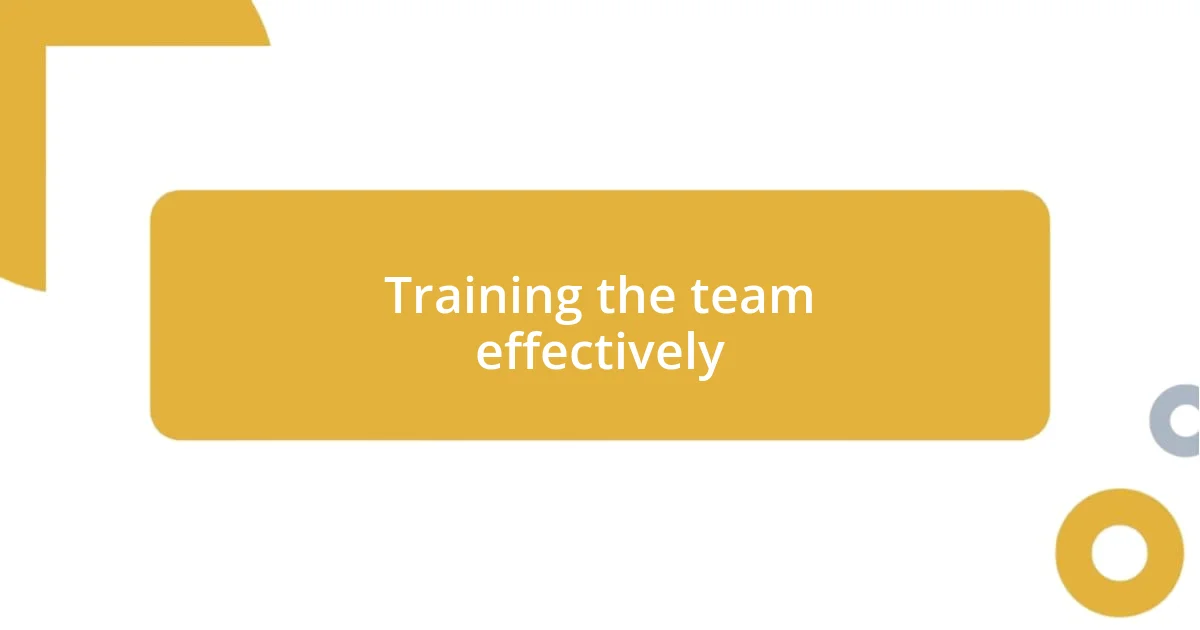
Training the team effectively
Training the team effectively was an integral part of our adaptation to new regulations. I’ll never forget the first training session we facilitated. As I stood in front of my colleagues, I felt a mix of excitement and nerves. It was crucial to create an atmosphere where everyone felt safe to ask questions—after all, we were all in this together. Have you ever shared a learning moment where the entire team feels like a part of the journey?
We devised an interactive workshop format that incorporated real-life scenarios relevant to their daily tasks. This approach turned abstract regulations into something tangible. I recall a moment when one staff member had an “aha” experience while role-playing a compliance situation. Watching her confidence grow right before my eyes was a powerful reminder of how effective training can be. I realized that fostering an engaging learning environment not only clarified the regulations but also motivated the team to embrace the changes.
Additionally, I sought feedback after each session. It became a trend for team members to express their thoughts over lunch, transforming casual conversations into productive discussions. I found that these informal settings often led to deeper insights about their needs and concerns. This feedback loop helped me tailor future training sessions. It’s incredible how comfort and openness can foster growth, isn’t it?
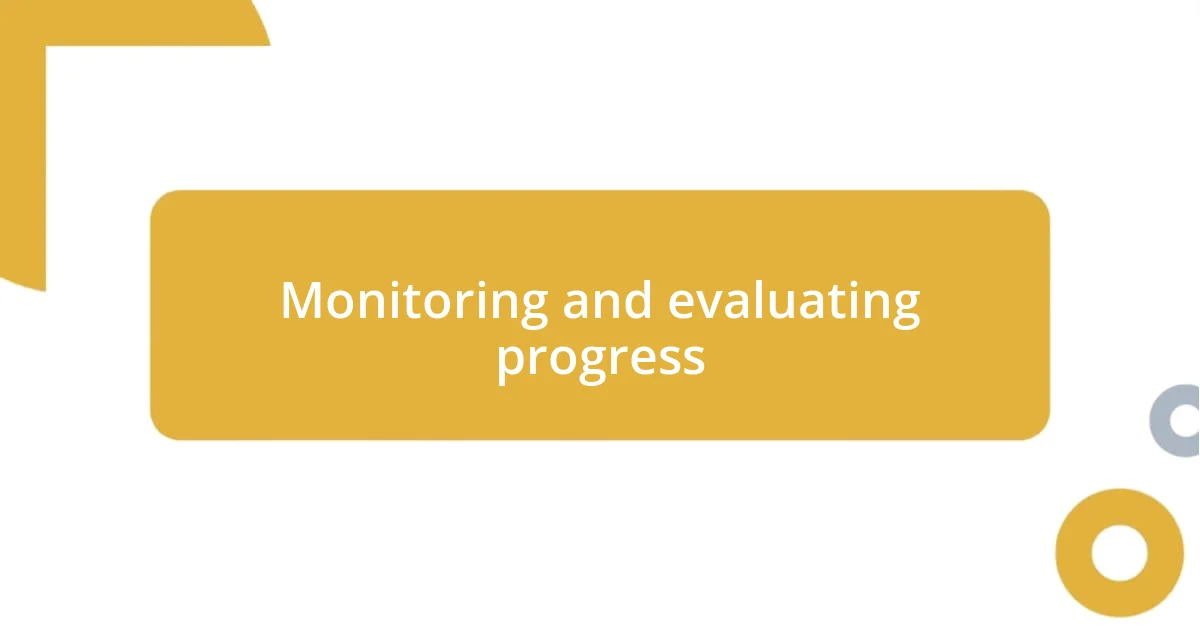
Monitoring and evaluating progress
Monitoring and evaluating progress became the backbone of our adaptation strategy. I remember sitting down one afternoon with a cup of coffee, analyzing the metrics we’d gathered since implementing the changes. It was a moment of truth; I couldn’t help but feel a mix of anxiety and curiosity. Were we on the right path? I quickly learned that keeping track of key performance indicators gave us not only clarity but also a sense of direction. Isn’t it reassuring to know you have a compass guiding you through your goals?
As the weeks unfolded, I became more attuned to the subtle shifts in our team’s dynamics. During our bi-weekly review meetings, I encouraged open conversations about what was working and what wasn’t. Once, a colleague revealed their struggles with a new process, prompting us to brainstorm creative solutions together. That felt empowering! It hit me then how important it was to create an environment where feedback was welcomed, as it led to real-time improvements. Do you ever notice how shared insights can spark innovation?
The process of monitoring wasn’t just about numbers; it was about stories and experiences. For example, I documented instances where our team went above and beyond to comply with the new regulations. These narratives showcased growth and resilience and served as motivation for everyone involved. Reflecting on such stories helped me appreciate the human element in what sometimes felt like a bureaucratic maze. Have you ever paused to celebrate small victories in your journey? I’ve found that these moments fuel our collective morale and drive forward momentum.
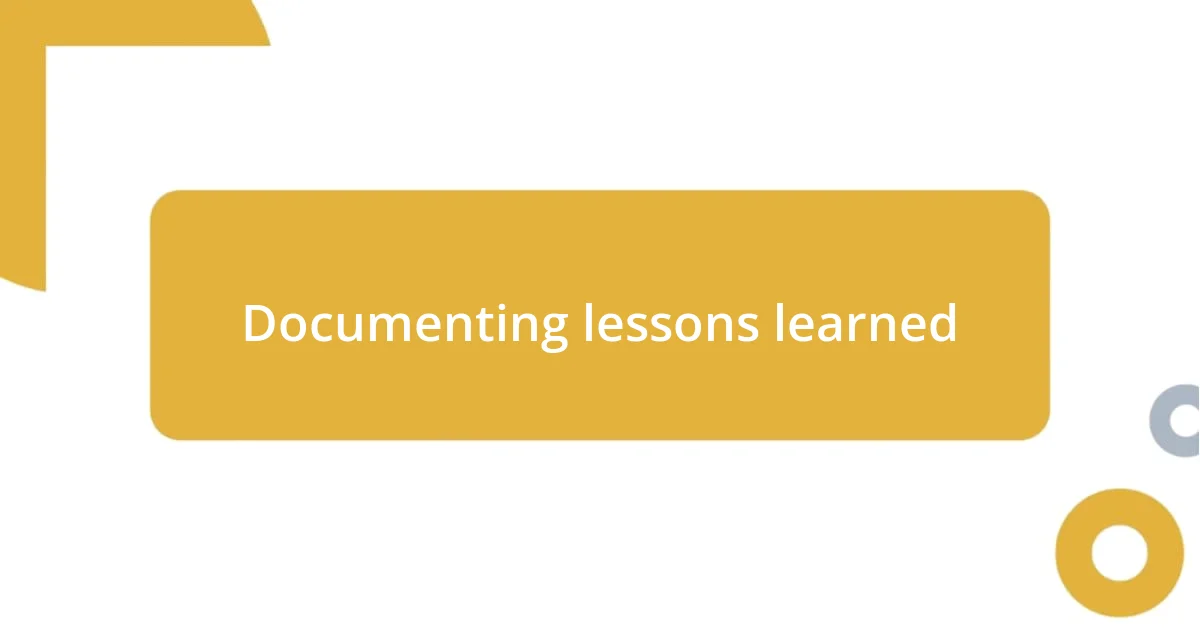
Documenting lessons learned
Documenting lessons learned turned out to be one of the most rewarding aspects of our journey. There were evenings when I would sit at my desk, reflecting on the challenges we faced. I often scribbled down what worked and what didn’t, capturing the essence of each lesson like snapshots in time. Have you ever realized that each failure can be a doorway to new insights? I truly believe that taking the time to document these moments reinforced my understanding and helped me to grow as a leader.
One particular experience stands out vividly. After one of our early training sessions, a teammate shared how a minor miscommunication had derailed their understanding of a key regulation. In that moment, I recognized it wasn’t just about sharing information; it was about creating a culture of transparency. By documenting these lessons, I was not only mapping our collective growth journey but also ensuring that future team members wouldn’t stumble over the same hurdles. Isn’t it empowering to think that by sharing our experiences, we can lay a smoother path for others?
The impact of preserving these lessons rippled through our organization. I made it a routine to revisit these documents during team meetings, sparking conversations that felt both nostalgic and forward-thinking. It was fascinating how revisiting past challenges produced not only laughter but also profound realizations about our evolution. Have you ever found that reflecting on the past can illuminate your future? I’ve seen firsthand how these discussions remind us where we’ve been, fueling our motivation to keep moving ahead.






